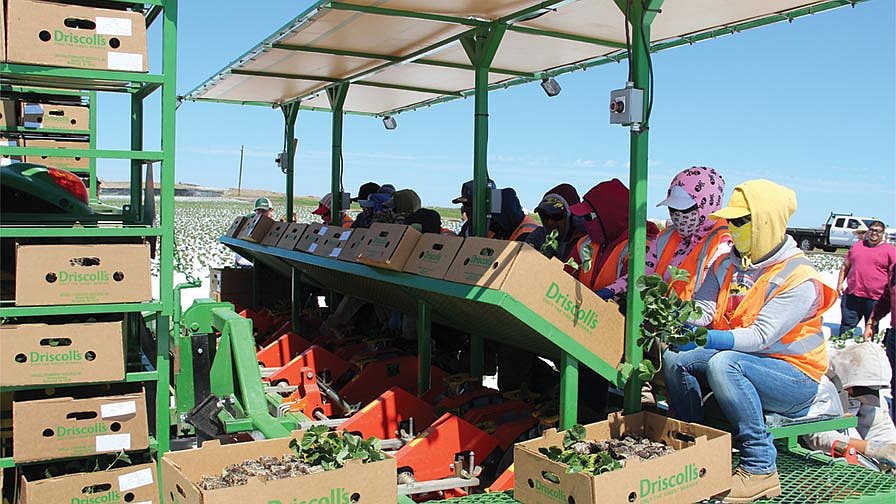COVID-19 & Election 2020 Could Delay Labor Reform Efforts

As if farm labor wasn’t enough of a worry for produce growers, COVID-19 has ramped up the anxiety even more. Photo credit: Surendra Dara
Despite ongoing news that demands our greater attention, let’s have a quick update on where ag labor reform stands.
Currently, there are developments to monitor on two fronts, says Kerry Scott, program manager with ag employment law firm MAS Labor.
On one front, the H-2A program is in the grips of it’s Notice of Proposed Rulemaking (NPRM) phase. Public comments have been collected and the government is in the process of issuing official responses to the comments deemed worthy. Officials have not provided a deadline of when they will complete that process. Nor are they required to issue one.
On the other front, the House-passed Farm Workforce Modernization Act (FWMA) is still in Senate conference. Senators are volleying various bipartisan changes and amendments back and forth across the Republican-dominated Senate.
Of course, recent happenings the world over have quite nearly made this conversation moot in the short term. With U.S. lawmakers called to emergency session late last week to work on COVID-19 relief legislation, and a likely quarantine period of indeterminate length looming for both legislative bodies once the work there is finished – not to mention greater economic concerns that will surely need immediate attention upon return – it begs the question whether Congress will find the time to take up ag labor reform at all?
“Hard to imagine they will accomplish that (passing FWMA through the Senate) this year, with everything else that is going on, and it’s an election year,” Scott advises. “What may very well happen, and I credit Craig Rugelbrugge at AmericanHort along with others, for this theory: Late summer, the Supreme Court is going to hand down some decisions about President Trump’s decision to end the DACA rule making. And how that goes may be something that would inspire Congress to actually get their heads together on these related matters.”
The timeline in that scenario places ag workforce reform back on lawmaker’s radars sometime around the coming 2020 Presidential Election, Scott adds.
“Whether they (farmers) are happy with either the (H-2A) rulemaking or with the actual FWMA will depend upon how they come out looking in the end,” he says. “Right now, there are things that we like and things that we don’t like in both. The good news is this is a process and in both cases nothing is a done deal.”
H2-A Update
With a final rule projected in place no earlier than first quarter 2021 now, it still bears mentioning that there are several aspects of reform that emerged from the 83,000-plus comments submitted that Scott and Co. at MAS Labor support.
The much-bemoaned local newspaper advertising requirement for open farm labor positions, which cost growers money without much return on that dollar in the form of prospective workers, has been phased out, Scott says.
“The growers will not have to do anything along those lines, the government will be doing it on their behalf, looking for the opportunity to fill these jobs with U.S. workers and whenever there is another downturn in the economy and unemployment spikes then there will probably be some people domestically that take those positions,” he explains.
In terms of outreach, Scott says that leaves the grower that uses H-2A for hiring with only one responsibility: reaching out to former workers from the previous season that are still in good standing with offers of continued employment this year, and documenting that effort.
“That’s the one thing the grower or his agent still has to do, but otherwise there is now no active recruiting being done by the employer or his agents, the government does it themselves,” he says.
The other change of note that took place with the H-2A program this year is a procedural one, Scott says.
“Historically, when you would file an H-2A application you’d file with the state workforce in your state and then two weeks later you’d file with the federal government at the Chicago National Processing Center,” he explains. “Now there is an automated process called FLAG where when you file with under that process you’re filing directly with the federal government and now they will handle reporting to the state themselves.”
Farm Workforce Modernization Act Update
For an update on FWMA, Scott advised we reach out to Michael Marsh, President and CEO of the National Council of Agricultural Employers (NCAE), who is reportedly working with North Carolina Senator Thom Tillis (R) on several amendments to the bill passed by the majority Democrat House of Representatives back in December.
According to Marsh, farmers have a number of concerns with the FWMA as currently composed, and the goal of Marsh and Tillis’ cooperation is to address these concerns during the Senate conferencing process so that they are incorporated into the final piece of legislation eventually signed into law by President Trump.
“One of those items (we take issue with) is the application of caps, or hard ceiling quotas, to the number of VISA workers available to the year-round program,” Marsh says during a telephone call from his Washington, DC, office. “Which effectively puts a limitation on the amount of food a farmer is able to produce, if you cap the labor force.”
Another issue some farmers have with FWMA is a new method for how farm worker wages will be calculated under the proposed regulations.
“Hypothetically, let’s say you’ve got two workers: one is working in the field picking peaches on a California orchard and that person is making $14 an hour,” Marsh explains. “Another individual is on your precision ag team, he’s got a degree in precision ag from Fresno State and he’s making $28 an hour doing ag tech on the farm.
“The way the new rule would work is, they survey your farm and those wages are added together and averaged, and now you’re obligated to pay everyone a base rate of $21 an hour and up. At that rate farm wages are just going to continue to spiral even further out of control.”
Additionally, Marsh is pushing Senate majority leadership to negotiate into the final bill some protections for the farmer/employer.
“There is a pathway to a green card for some and, potentially, legal status as a worker here, under many of these programs, but we feel that something that ought to exist from an H-2A employer perspective is that if a farm worker does indeed abscond, or leave voluntarily, from a job, thus violating his contract with the farmer, then that worker should no longer be afforded that potential legal status here in the U.S. under the program,” he says.
Marsh also takes issue with the House version in that it would extend the Migrant and Season Worker Protection Act, which he argues was originally intended for domestic laborers, to the H-2A workforce.
“Farmers are objecting to that because it opens them up to further litigation and attorney actions,” Marsh says, adding that a large civil Class Action would potentially be on the table going forward if the bill isn’t changed.
“According to the 2017 Ag Census numbers there are 2.4 million ag workers here in the U.S., and it’s my experience that the majority of folks in rural America today, they overwhelmingly want to do the right thing,” Marsh says. “We understand this is a process and you’ve got two sides to this thing, and it’s (the final FWMA bill) not necessarily going to look 100% how we want it to look.
“But, from our perspective, the time is now to do something about this, but it’s tough to pass any kind of legislation through the Senate right now. It’s the legislative graveyard,” he continues. “If we can streamline the program, make it more efficient and digitize components of it, then that’s a good thing. The last time the Senate passed legislation on ag labor was 34 years ago.
“We can’t wait another 34 years.”










